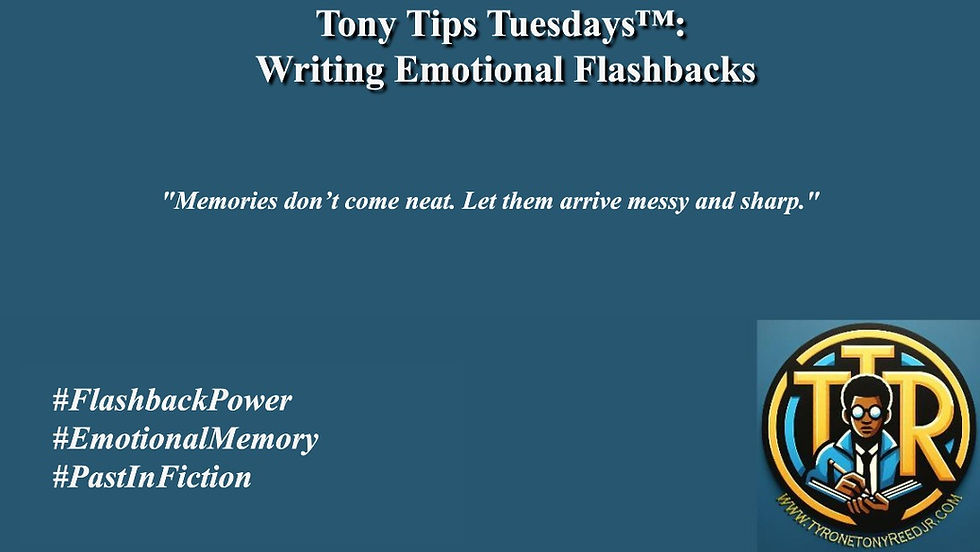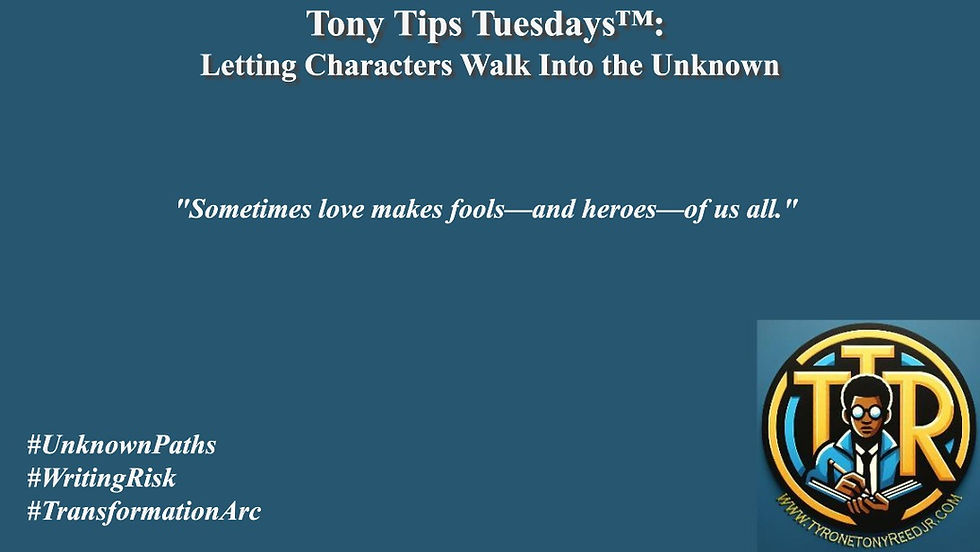Tony Tips Tuesdays™: Balancing Dialogue and Action
- Tyrone Tony Reed Jr.

- Aug 19
- 5 min read

Great storytelling is like great music—it’s all about rhythm, balance, and harmony. In fiction, the balance between dialogue and action is one of the most critical aspects of your pacing, character development, and reader engagement.
Too much dialogue, and the story can feel like a script with talking heads. Too much action, and readers may struggle to emotionally connect or understand motivation.
So how do you strike that perfect balance? Let’s break it down.
🗣️ Dialogue: The Voice of the Story
Dialogue reveals character, advances plot, deepens relationships, and often provides the emotional heartbeat of your story. When done well, it sounds authentic, carries subtext, and makes your characters feel real.
But dialogue can’t do everything.
📌 Tony Tip: If your characters talk too much without doing anything, you risk stalling the story.
⚔️ Action: The Movement of the Story
Action isn’t just car chases or explosions—it’s what your characters do. Whether they’re pouring coffee, pacing, running, fighting, kissing, or cleaning their gun before a mission—action reveals truth.
Actions show what characters believe, fear, want, and resist. But action alone, without internal or verbal context, can leave readers detached.
📌 Tony Tip: Action without dialogue is movement without meaning.
⚖️ Why Balance Matters
Imagine this:
A fast-paced action scene with zero dialogue: You might see what’s happening, but feel nothing.
A ten-page conversation in one room with no movement: You might understand the emotion, but lose the tension.
Balance is about flow—the ability to shift from movement to conversation without losing the reader’s interest.
📌 Tony Tip: The sweet spot is where dialogue fuels action, and action enhances dialogue.
🛠️ 1. Let Action Interrupt Dialogue
Real conversations don’t happen in a vacuum. People shift, pause, fidget, and react while speaking. Use this to your advantage.
Example:
Before (flat):“I can’t believe you did that,” she said. “What were you thinking?”“I don’t know,” he replied. “I just acted.”
After (balanced):“I can’t believe you did that,” she said, backing away. Her hands trembled.He looked down. “I don’t know,” he muttered. “I just acted.”
📌 Tony Tip: A raised eyebrow, a slammed door, or a silent stare can say more than words ever could.
💬 2. Let Dialogue Illuminate the Action
Conversely, action without commentary can feel emotionally flat. Use dialogue—or even internal monologue—to give readers access to the emotional layer of the moment.
Example:
He threw the punch. The man hit the floor.“That’s for what you did to her,” he said, voice shaking.
Now it’s personal. Now it’s story.
📌 Tony Tip: Action gains power when it has purpose. Let your characters voice that purpose.
🧱 3. Build Scenes with a Natural Weave
A great scene typically has a cadence like this:
A line of dialogue
A beat of action or reaction
A brief description or thought
Back to dialogue
This pattern creates flow, prevents info dumps, and keeps readers visually grounded.
Example Flow:
“We can’t stay here,” Malik said. He looked toward the treeline, fingers twitching on the grip of his knife.“They’ll find us by nightfall.”
Jade folded the map slowly. “Then we move now.”
📌 Tony Tip: Think of dialogue and action like dance partners—each leads for a beat, then follows.
🔥 4. Use Dialogue to Raise Stakes—Then Let Action Deliver
You can create powerful suspense by having characters talk about what’s coming—then act on it.
Example:
“If they catch us, it’s over.”“Then we don’t let them catch us.”They ran.
That last line hits hard because the action follows a loaded conversation.
📌 Tony Tip: Dialogue raises the emotional stakes. Action proves what’s at risk.
💣 5. Avoid "Talking Heads" and “Floating Limbs”
If you have several lines of dialogue back-to-back without physical movement or setting description, readers lose track of the scene’s physical space.
Add action tags to:
Ground the reader
Show how characters feel
Reveal hidden tension
Instead of:
“You don’t mean that.”
“I do.”
“Then leave.”
Try:
“You don’t mean that.” Her voice cracked.
He didn’t meet her eyes. “I do.”
She took a step back. “Then leave.”
📌 Tony Tip: Anchor your dialogue in space, movement, and emotion.
🎯 6. Action Doesn’t Have to Be Big to Be Meaningful
Not every action has to be explosive. Sometimes the smallest movement holds the most weight.
A thumb grazing a photo
A cigarette burning to the filter
A sigh held too long
A footstep that doesn’t turn back
These micro-actions can interrupt dialogue, suggest emotion, and deepen your scene.
📌 Tony Tip: In the right context, a whisper is louder than a scream.
📝 7. Let Characters Talk During Action
You don’t always have to separate action and dialogue. Some of the best scenes feature both happening at the same time.
Examples:
While escaping: “Any more bright ideas?” she gasped, dodging another branch. “Yeah,” he said, “run faster!”
During a fight: “You always were predictable,” he grunted, blocking a punch.
📌 Tony Tip: Let dialogue break up action and keep it human, grounded, and sharp.
🧠 8. Balance Introspection, Too
Balance isn’t just dialogue vs. action—it also includes internal thoughts. Use them sparingly to add emotional insight without slowing the pace.
Let your character:
Reflect briefly mid-action
Question themselves during a conversation
Reveal what they wish they’d said after the fact
📌 Tony Tip: The right thought, in the right moment, can be louder than the loudest action.
🔁 9. Revise for Rhythm
When editing, read your scenes out loud. If the dialogue feels endless, add action. If the action overwhelms, insert conversation or reflection.
Look for:
Long blocks of speech with no breaks
Paragraphs of movement without emotion
Repetitive structure in dialogue or description
📌 Tony Tip: Revision is where your story learns to breathe.
🎙️ 10. Emotional Beats = Stronger Pacing
The most memorable scenes are often emotional peaks. Use the combination of dialogue and action to build those moments with care.
Let the dialogue rise in intensity.Let the action match or contradict it.Then let it explode, fall apart, or reveal something unexpected.
📌 Tony Tip: Every emotional payoff deserves physical expression.
🔄 Bonus: Quick Cheat Sheet for Balance
SCENE TYPE | BALANCE FOCUS |
Romantic Tension | Subtext in dialogue + subtle physical cues |
Action Sequence | Sharp movements + punchy one-liners |
Emotional Confrontation | Body language + escalating dialogue |
Quiet Moment | Gentle action + reflective dialogue |
Mystery / Suspense | Limited dialogue + investigative movement |
📌 Tony Tip: Different scenes call for different ratios. Adjust accordingly.
✍🏾 Final Thoughts: Give the Reader a Full Experience
A great story engages the mind, heart, and senses. And that happens when you balance what your characters say with what they do.
Let your dialogue spark connection. Let your action drive momentum. And let your reader feel like they’re watching the story unfold in real time.
📌 Tony Tip: Balance isn’t about symmetry—it’s about impact.
📚 Want to See Balance in Action?
If you want to experience this kind of balance firsthand, dive into my original series S.O.L.A.D.™: Soldiers of Light Against Darkness™. You’ll find action-packed moments, heart-gripping conversations, and characters who move and speak with purpose.
💥 Grab your autographed copies directly from me at:👉🏾 www.tyronetonyreedjr.com/the-shop
📌 Tony Tip: When dialogue and action are in harmony, your story sings.



Comments